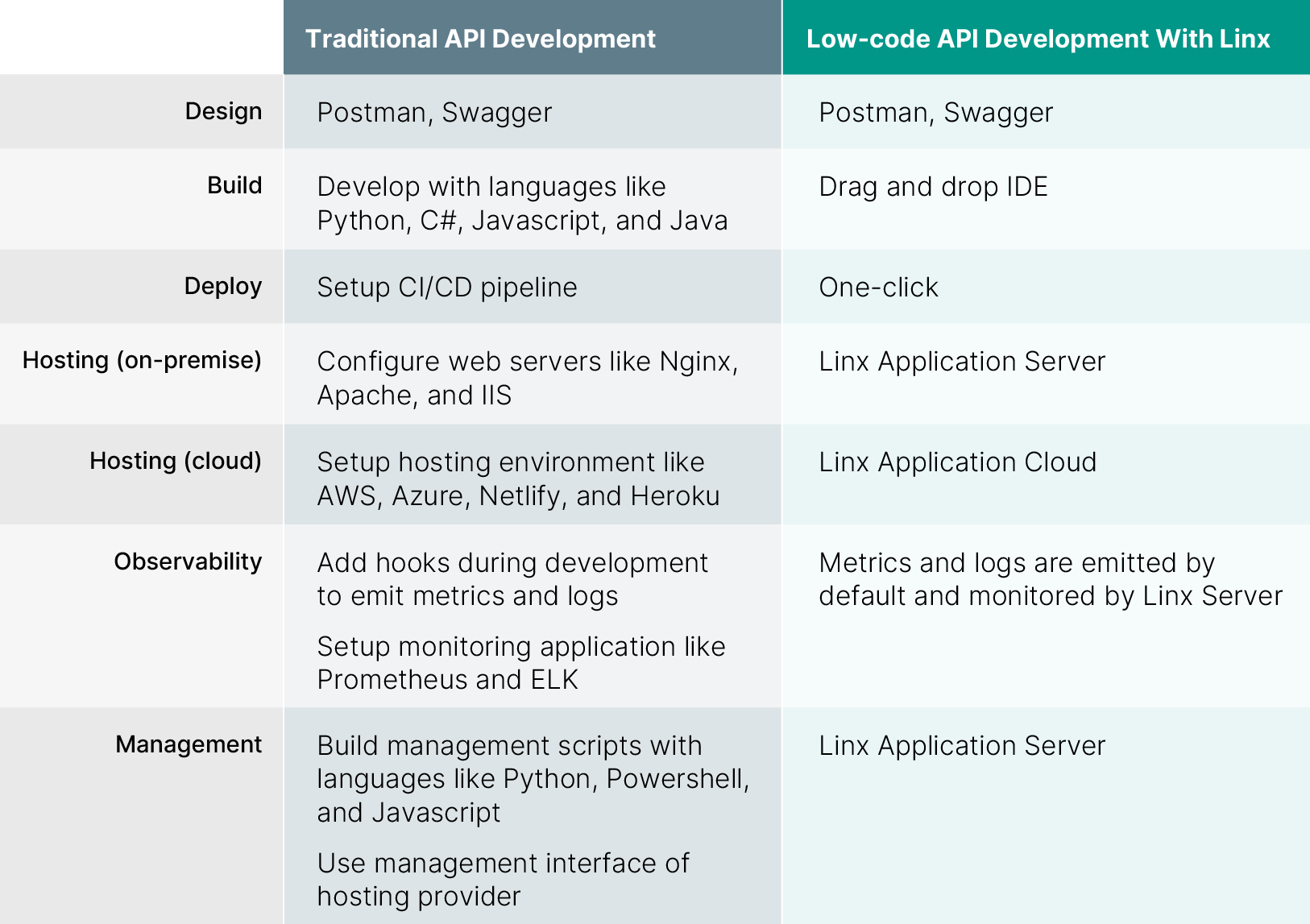An API provides several benefits to an organisation, but without a dedicated team of trained developers, it might seem impossible. Developers are expensive, and it can take months to develop an API from the ground up. If you don’t want to outsource or have in-house capability to build internal APIs, a low-code API builder might be the answer.
Before you begin: Plan long-term, start small
Requirements gathering and ensuring that you understand what you need to build is a good logical start. For a small one-page application, this might only be a day or two of talking with stakeholders and designing business logic. This first step aims to ensure that the API covers all use cases and provides stakeholders with what they need. Refactoring an entire coding design due to missing business logic is not only frustrating for the development team. It also adds inflated cost and time to the API project.
During the planning and design stage, remember that running an API requires more infrastructure than resources to execute endpoint logic. You may need:
- A database to store the data.
- An email system to send messages
- Storage for files
- Security to handle authorisation and authentication
- A Server to host your application
These services can be farmed out to cloud providers to expedite the API build process (e.g. AWS provides all these infrastructure components, but Microsoft Azure is an optional cloud provider with SendGrid as the email application.)
Something worth noting is that a low-code API builder can significantly help mitigate challenges faced when requirements are missed. Altering an application built with a low-code development platform is usually easier, thus paving the way for prototyping and fast MVP (Minimal Viable Product) rollout.
Planning considerations:
A REST API “speaks” in JSON or XML, so the output provided to client applications should be decided. Should you choose to later create endpoints for public developer consumption, you could offer both for ease of use and to foster more adoption. Ensuring the API follows OpenAPI standards will encourage adoption and attract more developers. Other sections of your design should include:
- Endpoint locations and names.
- Methods (e.g. POST, PUT, GET, DELETE)
- Database fields that will work with API methods and store data.
- Who will be able to access the API? Will it be public or only for internal authenticated users? Authentication and authorisation are critical for API security.
- Where will services be hosted – locally or in the cloud?
Building the API: Consider the options
Building APIs with the right logic and functionality entirely in tune with the design can be challenging. Therefore you need to figure out how to get around limitations, configure frameworks and web server infrastructure. If you have back-end developer skills and time is not a significant factor, pick the programming framework that your development team is familiar with. The most popular examples are;
Building a fully functional REST API from the ground up is a large project for any developer. It can be even more challenging for IT professionals unfamiliar with how APIs are coded, deployed, and maintained.
If you have limited development skills or time, a low-code API builder or development platform can greatly assist in your API development efforts. A low-code development platform such as Linx provides a platform for the rapid development of an API. The GUI makes development fast and efficient, you can even define your API with a wizard.
Low-code API development guides
- Design-first using an OpenAPI specification
- Code-first API builder, fast implementation, including hosting and documentation
Low-code APIs
Low-code tools can speed up development of APIs, streamline deployment and assist with hosting and management. The Linx Designer, a low-code backend development IDE, has many pre-wrapped development functions. Linx reduces 100s of lines of code to a single visual function with configurable properties. By using these functions, developers can quickly implement sophisticated technologies and integrate them with a wide range of APIs and services. The objects created in the Linx Designer must be defined, so understanding basic data type structures and objects is necessary.
With Linx, your API can work with several plugins, including cloud-driven tools. For instance, an API could generate an Excel file from specified endpoint input. Various different plugins allow you to create logic-rich APIs and applications. Examples include
- Consuming and generating files (Such as text, CSV, Excel, PDF and more)
- Interacting with internal and external APIs (REST and SOAP)
- Interacting with cloud-based services such as Google Drive
- Interacting with databases
- Executing custom SQL queries (Simple or complex)
- Executing custom-built logic (IF-ELSE, Loops and more)
The result is a customised API designed to your specific business use case. For standard APIs, using Linx could reduce development time by weeks. The alternative option of drag-drop-configure becomes rather appealing than the sourcing, hiring and managing of a development team.
Simple API Hosting
After the API is built, it must be deployed to an environment that hosts endpoints and takes requests. With traditional API deployment, you would be responsible for the hosting environment. This inevitably comes with its own concerns – you must maintain the infrastructure even if it’s hosted on AWS or Azure. Any infrastructure must also be deployed simultaneously (database objects, files, storage configurations, and plugins).
Linx offers an application server where you can deploy, host and manage the applications created on the platform. This feature makes it easier to host the API instead of configuring it to work with your internal environment. Maintaining an API internally can be a lot of overhead for an already overworked IT staff. Linx also allows for one-click deployments, meaning you do not have to set up a complicated deployment pipeline for Linx applications.

API development does not need to be a time, labour and skill-intensive exercise. Using a low-code development platform, you can rapidly create, host and maintain fully customizable and flexible APIs. Choosing a low-code API builder can save costs, time and developer effort.
